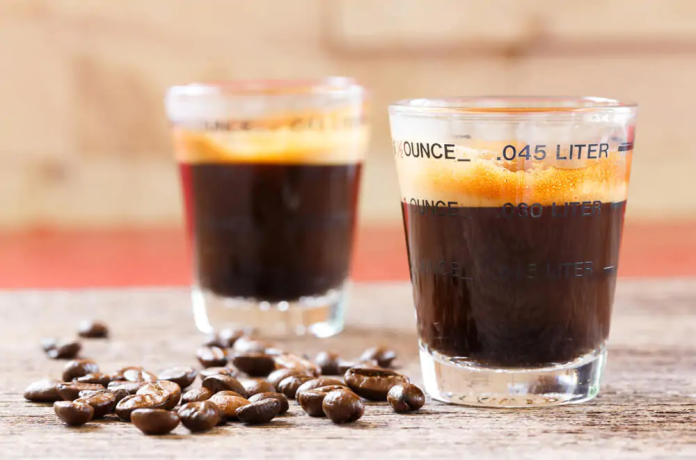How Many Ounces in a Cup of Coffee
A standard cup of coffee is typically measured as 6 fluid ounces (177 milliliters). However, coffee cups can vary in size, and different countries might use different cup sizes for measuring coffee. Additionally, when people refer to a “cup” of coffee, they might be referring to the mug or container they use, which can hold more than the standard 6 fluid ounces. Read about How to Grind Coffee Beans
Understanding Coffee Measurements
Deciphering the Coffee-to-Water Ratio
Before we tackle the ounces in a cup of coffee, let’s first understand the essential coffee-to-water ratio. Achieving the perfect brew hinges on this ratio, which typically falls around 1 to 2 tablespoons of coffee grounds for every 6 ounces of water. This delicate balance ensures that the flavors are extracted optimally.
Also read the Article: How Much Coffee for 12 Cups
Standard Cup Size Variations
Coffee cups come in a variety of sizes, which can lead to confusion. The standard cup size, often used for measurement, is 8 fluid ounces. However, many coffee shops offer various sizes, ranging from a “short” 8-ounce cup to a larger 16-ounce “grande” cup. These variations can impact the amount of coffee you’re actually getting.
Unveiling how many ounces in a cup of coffee
The Classic 8-Ounce Cup
The traditional 8-ounce cup, often referred to as a “standard” cup, holds approximately 6 to 7 ounces of actual coffee after factoring in space for cream or milk. This is the classic measurement that many recipes and coffee enthusiasts use as a benchmark.
Embracing the 12-ounce Mug
Moving up the scale, a 12-ounce coffee mug typically contains around 9 to 10 ounces of coffee. This site is popular in many households and provides a bit more of that energizing brew to kickstart your day.
The Mighty 16-ounce Grande
For those who need an extra dose of caffeine, the 16-ounce grande cup holds about 12 to 13 ounces of coffee. This site is a staple at many cafes and offers a substantial amount of coffee to keep you awake and alert.
The World of Specialty and Oversized Cups
Beyond the standard sizes, coffee aficionados may encounter even larger mugs, some exceeding 20 ounces. These cups can hold anywhere from 15 to 18 ounces of coffee, ensuring you have a hearty supply to fuel your activities.
Factors Affecting Coffee Measurements
Coffee Bean Varieties and Grind
The type of coffee beans you use and the grind level can impact the amount of coffee needed for a certain volume. Finely ground beans tend to compact more, requiring slightly less coffee than coarsely ground beans to achieve the same strength.
Brew Method and Extraction
Different brewing methods, such as pour-over, drip, or espresso, can affect how much coffee is extracted from the grounds. Espresso shots, for example, are highly concentrated and typically measure around 1 to 2 ounces.
Navigating the World of Coffee Measurements
The Coffee-to-Water Alchemy
Before we delve into ounces, let’s explore the cornerstone of coffee making – the coffee-to-water ratio. This is where the art and science of brewing intertwine. Typically, a well-balanced brew involves 1 to 2 tablespoons of coffee grounds for every 6 ounces of water. This ratio is the secret sauce for extracting the rich flavors locked within those beans.
Dance of Coffee Beans and Grind
Coffee beans and their grind play a significant role in measurements. Finely ground beans are denser, requiring less volume to produce the same strength of coffee as coarsely ground beans. The intricacies of this dance are what make each cup unique.
Brew Methods: A Flavorful Symphony
Brewing methods orchestrate the extraction process, influencing how much coffee essence is drawn from the grounds. Espresso, for instance, delivers a highly concentrated 1 to 2-ounce shot, while a French press extracts more coffee for a larger cup.
Decoding Cup Sizes
The journey through coffee measurements begins with cups, and let’s admit it, they come in various shapes and sizes. The standard reference point is an 8-fluid-ounce cup, but coffee establishments often offer an array of sizes, each contributing to the caffeine equation differently.
The Science of Coffee Proportions
Balancing Beans and Water
Before we unravel ounces, let’s get into the nitty-gritty of coffee proportions. The coffee-to-water ratio is the backbone of a great brew. A standard ratio involves 1 to 2 tablespoons of coffee for every 6 ounces of water. This equation determines the strength and flavor profile of your coffee adventure.
The World of Cup Sizes
Cups come in all shapes and sizes, much like the coffee enthusiasts who cherish them. An 8-fluid-ounce cup is the benchmark, but coffee shops thrive on variety, offering sizes that lead to different coffee experiences.
Brewing Dynamics
Choreography of Beans and Grind
Coffee beans and grind unite in an intricate dance. Finely ground beans are compact, requiring fewer grounds compared to coarser grinds for a similar-strength brew.
The Art of Extraction
Brewing methods curate the coffee experience. A concentrated 1 to 2-ounce espresso shot demonstrates precision, while a French press extracts more for a bold cup.
Savoring the Insights
As the aromatic steam rises from your cup, take a moment to appreciate the complexities that brought that coffee to your lips. The ounces in a cup of coffee encapsulate a tale of balance, precision, and craftsmanship. So, whether you’re sipping from the classic 8-ounce cup or embracing the robustness of the 16-ounce grande, now you’re equipped with the knowledge of what lies within.
Conclusion
In the world of coffee, measurements matter. Understanding how many ounces in a cup of coffee can elevate your brewing game and help you tailor your coffee experience to perfection. Whether you’re a fan of the classic 8-ounce cup or you prefer the robustness of a 16-ounce grande, now you can sip with confidence, knowing exactly how much coffee you’re enjoying.
FAQs
Q1: Is the coffee-to-water ratio the same for all brewing methods?
A: The coffee-to-water ratio may vary slightly depending on the brewing method. Experimentation can help you find the ideal ratio for your preferred method.
Q2: Why do larger cups hold less coffee proportionally?
A: Larger cups need to leave room for additives like cream or milk while maintaining a balanced flavor profile.
Q3: Can I use a kitchen scale for precise measurements?
A: Absolutely! Using a kitchen scale to measure coffee grounds and water can help you achieve consistent results.
Q4: How do coffee shops determine their cup sizes?
A: Coffee shops often base their cup sizes on customer preferences and industry standards, with slight variations for their unique offerings.
Q5: Does the altitude at which I brew my coffee affect the measurements?
A: Yes, at higher altitudes, water boils at a lower temperature, impacting the extraction process. Adjustments may be needed for optimal results.




